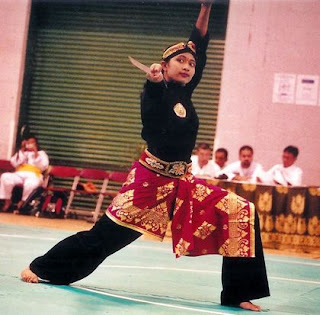Pencak Silat
Pencak Silat is an umbrella term for the martial arts created in Indonesia. The leading organization of pencak silat in Indonesia is IPSI [Ikatan Pencak Silat Indonesia meaning Organization for Indonesian Pencak Silat]. The liaison body for international pencak silat is the International Pencak Silat Association or PERSILAT.
Pencak silat was chosen in 1948 as a unifying term for the Indonesian fighting styles. It was a compound of the two most commonly used words for martial arts in Indonesia. Pencak was the termused in Central and East Java, while silat was used in Sumatra. In modern usage, pencak and silat are seen as being two aspects of the same practice. Pencak is the performance aspects of the martial arts, while silat is the essence of the fighting and self-defense.
The origin of the words pencak and silat have not been proven. Some believe that pencak silat comes from the Sanskrit word panca meaning five, or from Chinese pencha meaning avert or deflect. The most prominent origin theory of the word silat is that it derives from sekilat which means "as [fast as] lightning". this may have been used to describe a warrior's movements before eventually being shortened to silat. Some believe it may come from the word elat which means to fool or trick. The word pencak appeared in the Malay language as early as Adat Raja Melayu the text: 1779; manuscripts: 1817, 1873, provenance: text & manuscripts: Melaka.
History
The pencak silat tradition is mostly oral, having been passed down almost entirely by word of mouth. In the absence of written records, much of its history is known only through myth and archaeological evidence. The primary weapons of Indonesia's tribal were the single-edge sword, shield and javelin. The inhabitants of Nias Island had until the 20th century remained largely untouched by the outside world. However, they are culturally similar to the Himalayan Naga tribe. Neighbouring Sumatrans are said to have left the Nias people alone because they were fearless warriors.
India and China were the first civilizations from outside Southeast Asia with whom Indonesia made contact. Both countries influenced the local culture, religion and martial arts. Bas-reliefs in Srivijaya depict warriors wielding such weapons as the jian or Chinese straight sword, which is still used in some styles today. Additionally, javanese blades are of Indian derivation. It was during this period that silat was first formulised. The earliest evidence of silat being taught in a structured manner comes from the Sumatra-based empire of Srivijaya where folklore tells that it was created by a woman named Rama Sukana who witnessed a fight between a tiger and a large bird. By using the animals' movements, she was able to fend off a group of drunken men that attacked her. She then taught the techniques to her husband Rama Isruna from whom they were formally passed down. There are several variations of this story depending on the region where it is told. On the island of Boyan [Bawean], Rama Sukana is believed to have watched monkeys fighting each other while the Sundanese of West Java believe that she created cimande after seeing a monkey battle a tiger. The accuracy of this legend cannot be substantiated but the fact that silat is attributed to a woman is thought to indicate their prominence in ancient Southeast Asian society.
Srivijaya had control of the Melaka Straits, making it one of the most powerful kingdoms in the history of Southeast Asia. Its reign encompassed what are now Sumatra, Singapore, western Borneo, peninsular Malaysia and Thailand. The empire was also a center of learning and religion, attracting scholars and holymen from around the Southeast Asian region. More than a thousand Buddhist monks were living and studying in Srivijaya-ruled Sumatra alone. Among them were Javanese, Siamese, Malays, Chams, and Chinese. This not only allowed pencak silat to spread throughout the archipelago but also brought the art into contact with what would become sibling fighting systems.
While Srivijaya dominated the coastal areas, the Sanjaya [or Mataram] and Sailendrakingdoms ruled Central Java. Pencak silat especially flourished in Java which is now home to more different styles than any other Indonesian islands. In the 13th century, Srivijaya was defeated by the Cholas of South India. This was followed by the decline of the Sailendra and Sanjaya kingdoms but it also gave rise to the Majapahit empire. This was the first empire to unite all of Indonesia's major islands. From its base in eastern Java, Indonesian culture flowered and pencak silat bacame highly refined. Weapons made by Majapahit smiths were greatly prized in the Malay Peninsula, such as the famed Kris Taming Sari.
The influence of silat from the mainland was consolidated by Ninik Dato' Suri Diraja [1097-1198] to create silek or Minangkabau silat in Sumatra. Pencak silat was later used by Indonesian freedom-fighters against Dutch colonists. During this time the Bugis and Makassar people from South Sulawesi were very well-known as expert sailors, navigators and warriors. After Indonesia's Independence, pencak silat was brought to Europe by Indo people of Eurasian [mixed Indonesian and European] ancestry, such as the well known Paatje Phefferkorn. The art is now popular in the Netherlands, Spain and France. Schools can also be found in the USA.























